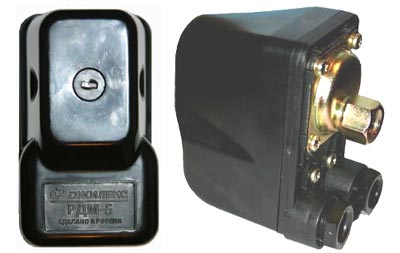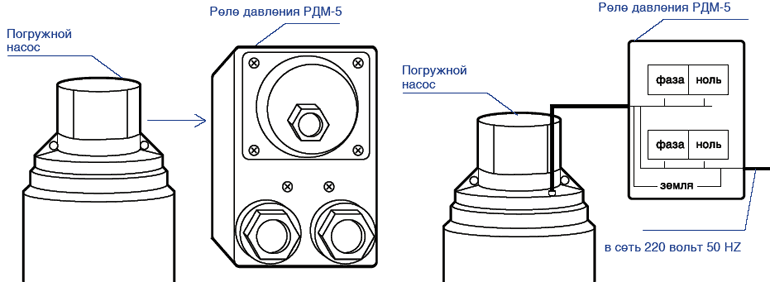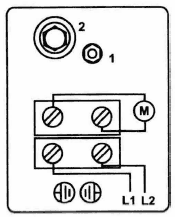Water station adjustment. Infrared heaters
A relay is a kind of pressure controller at which the water supply resumes and stops. For each pumping station there is its own power and volume of the drive, where water enters for supply to the tap, so it is necessary to regulate this process. In the event that you have a factory assembly of the pump, which already includes all the components and relays including, then it will already be configured for this power and adjustment of the pressure switch for the pump not required. In all other cases, when your pumping station consists of various parts, you will need to adjust the regulator at the lower mark and at the top. What happens when water drops below a designated value? The pressure drops, the contacts in the relay are closed, the pump turns on and works. It will fill the tank until the water reaches the upper mark, then under its pressure, the electric circuit breaks and the relay stops the pump. It would seem that everything is extremely simple, but when setting up, you need to consider what pressure you need during the day, how many times a day the pump will turn on and off. The more often this happens, the faster all parts wear out. Therefore, it is necessary that the relay is adjusted to the required amount of water every day, no more.
This adjustment of the pressure switch for the pump is carried out as follows: Take an example of a relay of the brand RDM5, this is a frequently used part for a water pump.
A more specific example: when you turn on the pump, open the tap, and see when the pump turns on. Determine the pressure using a pressure gauge and with the lower bolt adjust the negative position or positive. At the same time, the pressure in the accumulator must be lower by 0.2 atmospheres, the value that you set on the relay, as the minimum mark. If the pressure in the accumulator will be at around 1.4, then in the relay it will be - 1.2. The pump shutdown is adjusted in reverse; you wait for the pump to turn off with the mixer closed. Also determine the pressure by the pressure gauge and adjust the upper bolt, it is larger in size. Turning it clockwise will increase, on the contrary, decrease pressure.
- OPERATING PRINCIPLE
The RDM-5 device is a two-contact relay for switching electrical circuits, triggered by water pressure. The principle of its operation is as follows: at a small (less than 1 atm. Or pre-configured value) pressure in the water supply system, the relay contacts are closed, that is, an electric current passes through them to one or another device (for example, a pump) that the relay controls; when the pressure in the system exceeds a certain (pre-configured) value, its contacts open, thus breaking the power circuit of the device’s controlled relay. After connecting and presetting, the pressure switch operates automatically. - INSTALLATION RECOMMENDATIONS
Electrical work, installation of a socket, fuses, their connection to the supply network and grounding must be carried out by an electrician in strict accordance with the "Rules for the Technical Operation of Consumer Electrical Installations" and the "Safety Rules for the Operation of Consumer Electrical Installations" (PTE and PTB). - ADJUSTMENT (SETUP)
Adjustment of the lower pressure limit RDM-5 is carried out by a nut (2), fixing the position of the spring. In order to increase the value of the lower pressure limit level, it is necessary to tighten the nut clockwise. In order to reduce the lower limit of the pressure level, you need to unscrew the nut counterclockwise, thereby loosening the spring. The nut (1) is used to adjust the delta (difference) between the lower and upper pressure limits. For example: If you need to raise the pump shut-off pressure to 3.5 atm, leaving the start-up pressure the same (1.4 atm), proceed as follows. Turn the nut 2 clockwise to increase the pump shut-off pressure to the required value, while the pump turn-on pressure will increase by the same amount. Further, by rotating the nut 1 clockwise, we achieve that the pump start pressure again becomes equal to 1, 4 atm. The cross section of the wires of the input electric cable should correspond to the power of the electric pump. The socket must be European type, with grounding. Ground connection required! - WARRANTY
Pressure switch RDM-5 is guaranteed against any manufacturing defect for 12 months from the date of purchase. The condition for free warranty service of the pressure switch is its careful operation with the correct voltage of the power supply network and the absence of mechanical damage. Damage caused by improper connection to the power supply and defective installation are not subject to warranty repair. ATTENTION! The warranty is not valid if the pressure switch has been disassembled, repaired or damaged by the buyer. The warranty does not provide compensation for property damage and injuries associated with the operation of the pressure switch. The warranty provides for the replacement and repair of pressure switches at our company, as well as in special service centers that have our permission. Delivery to the place of warranty service is at the buyer's expense.
The PM5 mechanical pressure switch is often supplied as a part of pumping stations and fully automates their operation by controlling the on and off of the pump. From the factory, the relay is supplied already configured in accordance with the standard settings: cut-off pressure 2.5 (3) and switch-on pressure 1.5 (1.8). The pressure is measured in atmospheres (Atm.) Or in bars (bar). By changing these standard settings, you can adjust the operating mode of the pumping station.
If the pumping station is delivered pre-assembled, then most likely it is already optimally configured and in most cases does not require additional adjustment. If the station is assembled from separate elements (pump, tank, etc.), then setting the pressure switch is mandatory, because there is a direct relationship between the accumulator volume, pump pressure and relay settings. The pressure switch is adjusted by rotating in one direction or another two clamping nuts marked "P" and "ΔP". The first is responsible for the shutdown pressure, the so-called upper limit. The second one governs "delta P" - the difference between the shut-off and turn-on pressures, that is, in fact, allows you to set a lower limit or turn-on pressure.
To understand what and where to rotate - consider the simplified principle of the pumping station:
1. The pump pumps water into the accumulator;
2. the water pressure in the tank increases, which can be seen by the pressure gauge, which is part of any pumping station;
3. When a certain pressure is reached, the pump is switched off due to the opening of the contacts in the pressure switch. it "certain pressure" and there is that "P" - upper limit;
4. as the water accumulated in the tank is used, the pressure decreases and when the lower limit is reached ( ΔP) the pump switches on again and the cycle repeats.
Pressure switch setting start by determining the air pressure in the empty tank of the accumulator and when the pumping station is disconnected from the network. Most often, a conventional automobile pump with a pressure gauge is used for this. The nipple is located in the upper part of the tank and is covered with a decorative cap. There should always be air in the tank and its pressure should be checked periodically - this will allow the station to work in the set parameters and increase the service life of the accumulator membrane.
According to popular belief, air pressure should be checked once a quarter and pumped up if necessary. However, you can do something simpler: by setting the upper and lower limits and starting the operation of the pumping station, you need to periodically monitor the on and off values \u200b\u200bby the water gauge. Since the limits of the relay are directly dependent on the air and water pressures in the tank, a spontaneous change in the shutdown value indicates a change in air pressure. For example, if the shutdown pressure of the pumping station is 3 Atm., And after a while this limit has changed to 4 Atm., Then the air pressure has decreased and the tank needs to be pumped up with a pump.
For the same reason, it is useless to set up a relay with a tank full of water. After all, adjusting the upper limit of the relay, in fact, a certain total pressure of water and air is adjusted, therefore, when the accumulator is full, it cannot be reliably said, in the tank 3.5 Atm. water and 1.5 air, or 4 Atm. water and 1 atm. air. After determining the air pressure, the pump station is connected to the network, the pump starts to pump water and turns off when it reaches set pressure. If you need to increase the shut-off pressure, then the nut "P" rotate clockwise, and if it is necessary to reduce it, it is against (usually there are “+” and “-” notations nearby). It should be rotated gradually - turn, half turn. Higher value "P", the more water the pump will pump and the less often it will turn on again.
Setting the upper limit, you need to understand that:
- the accumulator is designed for its maximum pressure and should not be exceeded;
- rubber hoses of faucets and other plumbing also have an allowable design pressure; the mechanics of the pressure switch itself has its own “ceiling”;
- the pump should be able to give the desired pressure, and an excessively high pressure in the system may simply be uncomfortable.
Then open the tap and drain the water from the pumping station. As the water flows, the pressure gradually drops and when the lower limit is reached, the pump switches on again. Turn the nut to adjust this parameter. "ΔP": if you need to lower the switching pressure, then clockwise, and if you increase - against. When setting this value, it should be remembered that the air pressure in the accumulator must always be 10% less than the pressure on which the pump is turned on. Failure to comply with this dependence causes accelerated wear of the tank membrane. The lower the lower limit, the more water the hydraulic accumulator can give out before turning on the pump, but at the same time its pressure in the system will drop as it approaches the moment of switching on and may turn out to be too low for comfortable use. In any case, the air pressure in the accumulator should not be lower than 0.8-0.9 Atm.
What are the meanings "P" and "ΔP" select? Each for himself determines this individually. High pressure shutdowns and low for switching on - a lot of water in the tank and rare switching on of the pump, but possible inconvenience due to the large pressure drop with a full and almost empty tank. And someone has a difference ΔP small and the pump often pumps water into the tank, but the pressure in the system is smooth and comfortable. It should also be noted that for all settings related to pressure gauges, their possible error must be taken into account. The rubbing parts of the movable plastic frame of the pressure switch initially have factory lubrication, but it is usually very small, so applying a lubricant is a reasonable solution.
Pressure switch RDM-5 for water supply
 Purpose and principle of action
Purpose and principle of action
Pressure switch RDM-5 It is used in automatic water supply systems. The working environment of systems that use a pressure switch RDM 5 should be water.
The RDM-5 device is a two-contact relay for switching electrical circuits, triggered by water pressure.
The principle of its operation is as follows: at a small (less than 1 atm. Or pre-configured value) pressure in the water supply system, the relay contacts are closed, that is, an electric current passes through them to one or another device (for example, a pump) that the relay controls;
when the pressure in the system exceeds a certain (pre-configured) value, its contacts open, thus breaking the power circuit of the device’s controlled relay.
After connecting and presetting, the pressure switch operates in automatic mode.
Specifications
Supply voltage: 220-230 V 50 Hz
Maximum rated power of the electric pump: NR 2
Working environment temperature: 0+ 40 ° С
Operating pressure range: 1.0-4.6 atm.
Factory setting:
the lower pressure limit is 1.4 atm.
upper pressure limit -2.8 atm.
Minimum pressure drop: 1.0 atm.
Connecting sizes: 1/4 "(vnutr.)
Degree of protection: 1P 44
Connecting a pressure switch to a submersible pump

Pressure switch adjustment

Adjustment of the lower pressure limit RDM-5 is carried out by a nut (2), fixing the position of the spring.
In order to increase the value of the lower pressure limit level, it is necessary to tighten the nut clockwise.
In order to reduce the lower limit of the pressure level, you need to unscrew the nut counterclockwise, thereby loosening the spring.
The nut (1) is used to adjust the delta (difference) between the lower and upper pressure limits.
For instance:
If you need to raise the pump shut-off pressure to 3.5 atm., Leaving the start-up pressure the same (1.4 atm.), Proceed as follows.
Turn the nut 2 clockwise to increase the pump shut-off pressure to the required value, while the pump turn-on pressure will increase by the same amount.
Further, by rotating the nut 1 clockwise, we achieve that the pump start pressure again becomes equal to 1, 4 atm.
The cross section of the wires of the input electric cable should correspond to the power of the electric pump. The socket must be European type, with grounding. Ground connection required!



